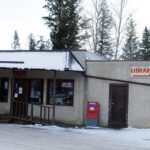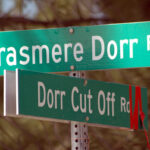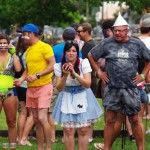Home »

A rookie pilot’s nightmare
By Elinor Florence
Windermere’s Leo Richer was a Lancaster bomber pilot in the Second World War. I was fortunate enough to interview him before his death, and he gave me a copy of his own memoir, called I Flew the Lancaster Bomber. In the book, he describes one particularly hair-raising incident.
Leo Richer grew up in Northern Ontario, where his father worked for a paper company. He was one of eight children, so he had to leave school early and work in the mill to help support his family. Although he had his heart set on being a pilot, at the start of the war the RCAF would only accept university graduates.
But by 1942, the RCAF was recruiting anybody with a Grade 8 education. Leo passed the IQ test and the physical with flying colours, and trained in Canada until May 1944. He sailed for England and trained on twin-engine bombers, and then on the mighty four-engine Lancaster.
The lead image above features Leo, standing in the centre of his seven-man crew.
Leo was still an inexperienced pilot when he crashed his Lancaster in December 1944. He was trying to land at RAF East Kirkby in Yorkshire with only two functioning engines and misjudged his speed.
Although the Lanc crashed into a pasture and broke into two pieces, luckily everyone survived – except a horse that died when it was struck by the starboard wing.
The entry in his logbook on the bottom right reads: “Target hard to see. Crashed at East Kirkby. No one hurt bad. Complete writeoff.”
He still had little practice with formation flying when he finally made his first bombing mission to Wesel, Germany on February 18, 1945. Here’s how he describes it:
“I soon learned that you kept at least 50 feet behind the Lanc ahead of you. His slipstream could stand you on your tail. We hadn’t been briefed on formation flying in a Lanc. Just get up there, chaps, and have a go at it. Typical English! You had to try to anticipate the deceleration or acceleration of your leader. With a wallowing, overladen aircraft, you worked your ass off just to keep within sight of him.”
“We took off individually and formed up at a designated rendezvous, or so we were supposed to. Trust me to screw up on my first Ops. I stooged around at the 10,000-feet level, looking for my squadron, finally saying to hell with it and deciding to go it alone. There were lots of Lancs aloft – it was a 1,000-bomber raid – so I just latched on to the nearest squadron and joined in the fun . . . I was scared shitless and just wanted to drop our bombs and get the hell home.
“It was a horrifying experience, watching a mortally-hit Lancaster go slowly spiraling down, trailing a dark plume of smoke, hoping against hope the would be able to bail out and stay alive.”
Leo made it back to base intact, but he was alarmed to find that his crew was marked down to go out again the very next night, to the same target of Wesel, Germany.
However, this time the raid would be led by an expert named Peter Francis Dunham, an acclaimed officer who had already received the Distinguished Flying Cross and had survived an unbelievable three tours. (A tour was 30 bombing raids – most men were lucky to survive one tour.)
“Today was to be a red-letter day. Wing Commander Dunham was to lead our squadron and the whole 1,000-bomber raid on this operation.
“Wing Commander Dunham had enlisted in the RAF in 1935. He was an air gunner when war broke out and did thirty ops in that capacity. He then remustered as a navigator and completed another tour. The man seemed to have a charmed life. The German fighter planes were plentiful in those early years and they were deadly. Many crews got shot down on their first mission. He had a lot of fight left in him so he asked to be sent to a pilot training school. He flew another thirty missions over Germany.”
“When my crew and I reported in at Tuddenham, 90 Squadron, (which we soon called Muddenham because of the rain), there he was. A very personable man, with a thatch of red hair and a handlebar moustache.
“He introduced himself right off the bat, bellied up to the bar and bought me a beer. He plied me with queries: my hometown in Canada, where I had trained, what planes I had flown, was I married or single, what did I think of the Lanc, etc.
“I was impressed that a wingco would even take time out to talk to a lowly sprog, let alone buy me a beer. Of course, I had no idea then that he was a 100-mission man. He never so much as hinted at that, but I guessed he’d been around a while by the ribbons under his wings and on his dress uniform, and the fact that he was a wingco.
“He drank gin and orange and, if you used the phone after him, you first had to wipe off the mouthpiece. His generous moustache would always tell you he’d been there. He lived life to the fullest; always had a smile and a cheerful greeting. And if one of us had a problem of any kind, he would gladly sit down and sort it all out with you. All aircrews thought the world of him and were happy to have such a man as our wingco.
“The group captain, overall commanding officer of 90 Squadron, was dead set against Dunham flying any more missions. He had been a World War One pilot and he realized the odds could work against you if you pushed your luck too far.
“So when Dunham volunteered to lead this raid on Wesel, the C.O. tried his best to dissuade him, but to no avail. Dunham was determined, as was his crew, to be on this mission. Of course, he could be very charming and persuasive when he chose to be. The group captain, having been there himself many years ago, finally gave in and gave him the green light.
“After briefing, my Lancaster was on the left of the leader, Dunham. Boy, was I ever excited. I couldn’t wait to catch up with Dunham and shake his hand and thank him. I knew he had done this to make it easier for me, being at the head of the formation, with no slipstream to worry about. Flying a Lanc in formation was a formidable task. I had only about six to eight hours of formation flying on single-engine Harvards at Uplands Air Force Flying School in Ottawa.
“Luckily, the cloud base was fairly high on takeoff, so I was able to catch up with Dunham and stay in half-decent formation while we struggled for altitude. A Lanc, with a 12,000-pound bomb in her belly, some 2,000 gallons of high-octane gas aboard, plus her own weight, added up to a staggering 35 tons or so.
“I think I probably lost five or six pounds on some of those first trips. I’d be wringing wet after every operation and couldn’t wait to get to the bathhouse. Showers and soaking relaxed those jangled nerves.”
“Wesel was heavily defended with anti-aircraft guns and they were plentiful and fairly accurate. We were at 22,000 feet, well over thick cloud cover, when those same guns opened up, peppering the sky with their exploding black puffs. My eyes were glued on Dunham’s Lanc, waiting for his bomb doors to open, when we would do the same.
“Then it happened. I think I screamed over the intercom to the bomb aimer: “Bomb doors, open!”
“About two seconds later, BOOM! Dunham and his crew were blown into eternity!
“We felt the shock wave; we were that close. I think I was in a kind of shock. The deputy commander on Dunham’s right took over, and we both dropped our bombs.
“I knew it had happened. Dunham was gone. His lucky streak finally strung out, but the irony of it all: here I was just on my second operation, flying erratically 30 or 40 feet away from Dunham, scared all to hell, and he gets the direct hit.
“Since then, I’ve been a firm believer in that popular saying: “When your time is up, you’re gone.”
Leo’s logbook shows the history of that fateful raid. It reads: “Cloud all the way – 9/10 over target. Formation good ‘til target. Flak very accurate. Sqd’n Wing-Co. blew up in P for Peter.”
Amazingly, a photograph exists (below) of that very explosion, taken by one of the automatic cameras installed in every bomber to assess bomb damage.
It was published in the book titled Lancaster at War 4: Pathfinder Squadron, by Alex Thorne.
When you look at the Lancasters flying around this gigantic fireball (and one of them shown here, I’m betting, is being flown by Leo Richer) you realize the magnitude of the explosion. The commander’s aircraft was hit by anti-aircraft fire before he dropped his bombs, which exploded on impact. Death for all aboard would have been instantaneous.
The caption below the photograph reads: “ONE OF OUR AIRCRAFT IS MISSING: A common announcement on BBC Radio most evenings, exemplified here by the “death” of Lancaster PD336 of 90 Squadron over Wesel on 19 February 1945, as its 10,000 lb. high explosive bomb load detonates after a direct hit from German flak. Crown Copyright.”
This incident was excerpted from Leo’s 76-page book of memoirs, I Flew the Lancaster Bomber, describing his early life, his days in the RCAF, and his later years. It’s available as an ebook or a paperback from Amazon. To order it, click here: I Flew the Lancaster Bomber.
Leo Richer flew until August 1945. One of his duties after the war ended was flying home the freed prisoners of war from the continent in his Lancaster.
After his return to Canada, he moved west to Windermere, British Columbia, where he started a water taxi business with his sister Edmae, a former Wren (Women’s Royal Canadian Naval Service). He named his water taxi R-Roger after the Lancaster.
In 1947 he married Winnifred Foster of London, Ontario, who had served in the Wrens with Edmae. The couple had two children, Roger and Sherry. They eventually purchased the general store and post office in the village of Windermere. Leo was also a well-known local musician who played in various bands all his life. Leo and Winnifred are now deceased. Roger is now a successful lawyer in Vancouver, and daughter Sherry is a retired teacher in Ontario.
* * * * *
Author appearance at Cranbrook Public Library
Elinor Florence, of Invermere, is the author of a dramatic new wartime novel called Bird’s Eye View, the only novel ever written featuring a Canadian woman in uniform as the main character. Her heroine Rose joins the Royal Canadian Air Force, goes overseas to England, and becomes an interpreter of aerial photographs.
Elinor will present a highly-entertaining slide show of vintage photographs and explain the research behind her novel at the Cranbrook Public Library, 7 p.m. Monday, November 16. After the event she will sell and sign copies of her book.







